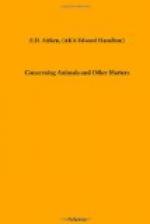The owl kills small birds, large insects, frogs and even fishes, but these are extras: its profession is rat-catching and mousing, and only those who have a very intimate personal acquaintance with it know how peculiarly its equipment and methods are adapted to this work. The falcon gives open chase to the wild duck, keeping above it if possible until near enough for a last spurt; then it comes down at a speed which is terrific, and, striking the duck from above, dashes it to the ground. The sparrow hawk plunges unexpectedly into a group of little birds and nips up one with a long outstretched foot before they have time to get clear of each other. The harrier skims over field, copse and meadow, suddenly rounding corners and topping fences and surprising small birds, or mice, on which it drops before they have recovered from their surprise.
The owl does none of these things. For one thing, it hunts in the night, when its sight is keenest and rats are abroad feeding. Its flight is almost noiseless and yet marvellously light and rapid when it pleases. Sailing over field, lane and hedgerow and examining the ground as it goes, it finds a likely place and takes a post of observation on a fence perhaps, or a sheaf of corn. Here it sits, bolt upright, all eyes. It sees a rat emerge from the grass and advance slowly, as it feeds, into open ground. There is no hurry, for the doom of that rat is already fixed. So the owl just sits and watches till the right moment has arrived; then it flits swiftly, softly, silently, across the intervening space and drops like a flake of snow. Without warning, or suspicion of danger, the rat feels eight sharp claws buried in its flesh. It protests with frantic squeals, but these are stopped with a nip that crunches its skull, and the owl is away with it to the old tower, where the hungry children are calling, with weird, impatient hisses, for something to eat.
The owl does not hunt the fields and hedgerows only. It goes to all places where rats or mice may be, reconnoitres farmyards, barns and dwelling houses and boldly enters open windows. Sometimes it hovers in the air, like a kestrel, scanning the ground below. And though its regular hunting hours are from dusk till dawn, it has been seen at work as late as nine or ten on a bright summer morning. But the vulgar boys of bird society are fond of mobbing it when it appears abroad by day, and it dislikes publicity.
The barn owl lays its eggs in the places which it inhabits. There is usually a thick bed of pellets on the floor, and it considers no other nest needful. The eggs are said to be laid in pairs. There may be two, four, or six, of different eggs, in the nest, and perhaps a young one, or two, at the same time. Eggs are found from April, or even March, till June or July, and there is, sometimes at any rate, a second brood as late as November or December. This owl does not hoot, but screeches. A weird and ghostly voice it is, from which, according to Ovid, the bird has its Latin name, Strix (pronounced “Streex,” probably, at that time).




